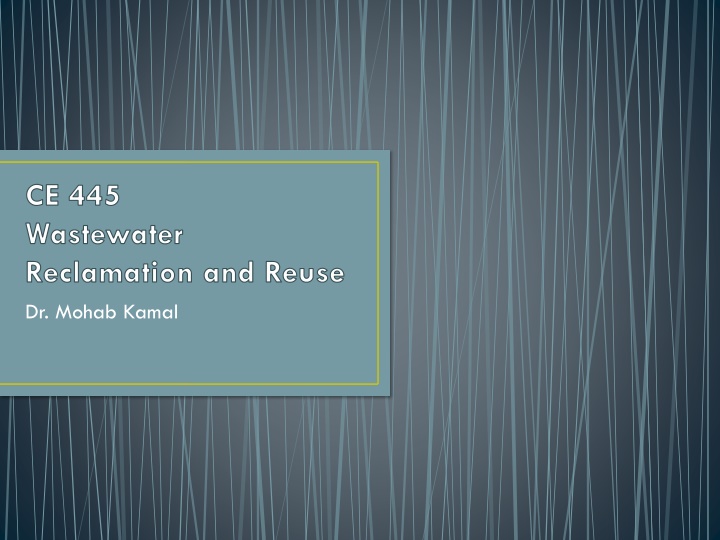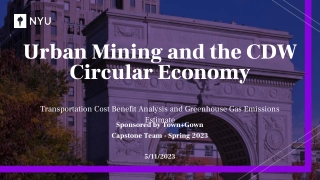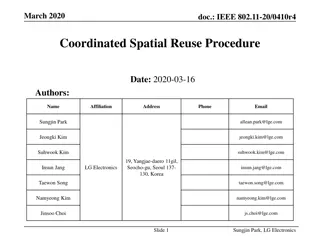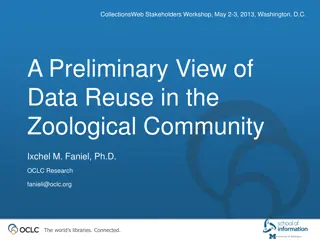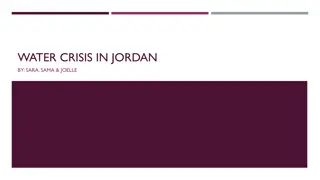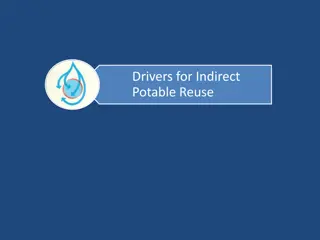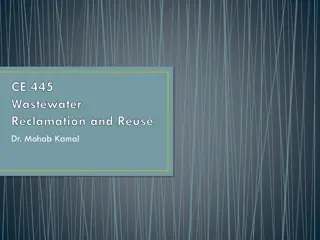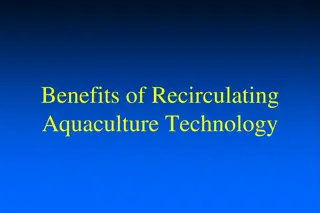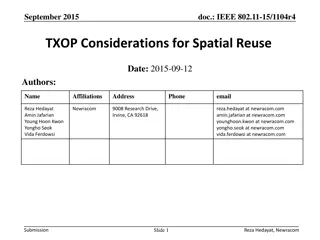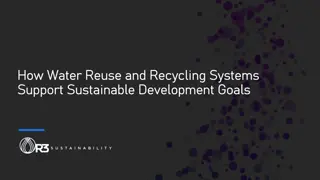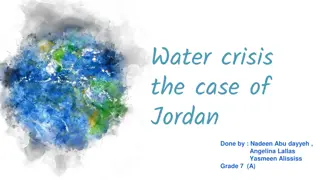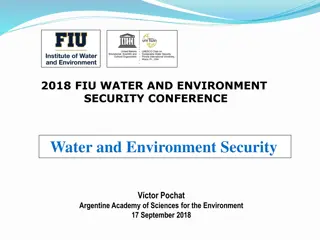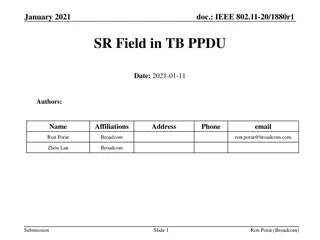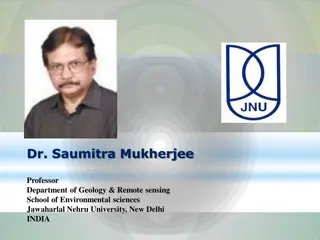Public Health and Environmental Challenges in Water Reuse
Despite advanced wastewater treatment processes, assessing the safety of reclaimed water and its environmental impact remains challenging. This section evaluates new scientific findings on water constituents, their removal requirements, and the criteria for water reuse.
Download Presentation

Please find below an Image/Link to download the presentation.
The content on the website is provided AS IS for your information and personal use only. It may not be sold, licensed, or shared on other websites without obtaining consent from the author.If you encounter any issues during the download, it is possible that the publisher has removed the file from their server.
You are allowed to download the files provided on this website for personal or commercial use, subject to the condition that they are used lawfully. All files are the property of their respective owners.
The content on the website is provided AS IS for your information and personal use only. It may not be sold, licensed, or shared on other websites without obtaining consent from the author.
E N D
Presentation Transcript
CE 445 Wastewater Reclamation and Reuse Dr. Mohab Kamal
Public Health and Environmental Issues in Water Reuse (Section 13 2) Despite the existence of technically proven advanced wastewater treatment processes, long-term safety of reclaimed water and the impact on the environment are still difficult to quantify. Given that is possible to produce water of almost any quality, public health and environmental issues that now must be addressed are: What constituents must be removed and to what extent must be removed? The purpose of this section is To evaluate the impact of new scientific findings and knowledge concerning the constituents in water, To examine the public health significance and environmental impact of the constituents in treated wastewater that is to be reused, And to review existing water reuse criteria and guidelines. CE 445 Water Reclamation and Reuse (Dr. Mohab Kamal) 2
Constituents in Reclaimed Water The constituents in municipal wastewater subject to treatment may be classified as: Conventional: those constituents measured in mg/L that have served as the basis for the design of most conventional wastewater treatment plants. Non-conventional: those constituents that may have to be removed or reduced using advanced wastewater treatment processes before the water can be used beneficially. Emerging: those classes of compounds measured in the micro- and nano- gram/L range that may pose long-term health concerns and environmental problems are more is known about the compounds. In some cases, those compounds cannot be removed effectively, even with advanced treatment processes. CE 445 Water Reclamation and Reuse (Dr. Mohab Kamal) 3
Classification of Typical Constituents found in Wastewater (Table 13 6) Classification Constituents Total suspended solids Colloidal solids Biological oxygen demand Chemical oxygen demand Total organic carbon Ammonia Nitrate Nitrite Total nitrogen Phosphorus Bacteria Protozoan cysts and oocytes Viruses Metals Total dissolved solids Conventional Refractory organics Volatile organic compounds Surfactants Non- conventional Prescription and non- prescription drugs Home care products Veterinary and human antibiotics Industrial and household products Sex and steroidal hormones Other endocrine disrupters Emerging CE 445 Water Reclamation and Reuse (Dr. Mohab Kamal) 4
Public Health Issues Over the past 10 years, a variety of new analytical techniques have been developed that can be used to measure extremely low concentrations of an ever-increasing variety of inorganic and organic constituents in water. As consequence, hundreds of organic compounds have been detected in untreated and treated wastewater at relatively low concentrations. Further, it has been found that the effectiveness of conventional and advanced wastewater processes varies considerably with respect to removal of theses individual compounds. For most of the emerging compounds, there is little or no information concerning health or environmental effects. Unfortunately, some of the compounds that have been identified in reclaimed water are known to have both acute and chronic health effects, depending on their concentrations ad exposure pathways. The dilemma posed by the presence of these trace amounts of organic compounds in reclaimed water is that the perceived or potential adverse health effects that may be caused by these compounds have not been quantified fully in current water reuse criteria and guidelines or drinking water standards. CE 445 Water Reclamation and Reuse (Dr. Mohab Kamal) 5
Environmental Issues Environmental risks associated with previously unknown or unrecognized chemicals in treated effluents have long been a concern for environmental scientists and engineers. In general, more than 60 percent of the drug residues that were detected at parts per billion (ppb) or parts per trillion (ppt) levels in the wastewater influent were removed in the activated sludge process. The long term environmental effects of these compounds found in treated effluent are, for the most part, not well understood, and the true significance of these trace quantities of constituents in the aquatic environment and in water supplies is still an issue of concern. The most troubling findings is that the concentrations of these compounds that cause environmental effects to aquatic organisms are considerably lower than the concentrations that cause any measurable effects in humans. CE 445 Water Reclamation and Reuse (Dr. Mohab Kamal) 6
Current Status of Reuse Regulations in KSA Regulations are used to ensure that public health and the environment are protected with the application of treated wastewater, which can be used both directly and indirectly in a variety of applications. The regulatory framework for reuse should also work to create public trust in the ability of treated wastewater to play a major role in water resources management within KSA as demands on existing groundwater and desalinated water supplies increase with a growing population and favorable economic climate for industries. KSA has recognized its water supply limitations as its population has grown and has begun more defined water resources planning with the National Water Plan in 1985, now updated as the National Water Strategy. CE 445 Water Reclamation and Reuse (Dr. Mohab Kamal) 7
Current Status of Reuse Regulations in KSA With progress such as KSA s plan for nearly complete reuse by 2025 in cities over 5,000 people, the current regulatory framework under the authority of MOWE and Ministry of Agriculture (MOA) is built on the following principles: Achievement of at least minimum treatment standards An approval and permitting process for the application of treated wastewater Monitoring of treated wastewater to ensure that it meets the standards Enforcement provisions to ensure that treated wastewater practices are following requirements CE 445 Water Reclamation and Reuse (Dr. Mohab Kamal) 8
Current Status of Reuse Regulations in KSA Varying applications of reclaimed water fall under different requirements within the regulations, depending on necessary treatment level and application type, as agricultural needs may differ from those of industries. Reclaimed water, when adequately treated, can offset other potable water demands and decrease wastewater discharges. These benefits, both environmental and economic, also exist for using biosolids, such as for a soil conditioner and/or nutrient source, rather than disposing of them in landfills, as is currently the most popular disposal choice in KSA. CE 445 Water Reclamation and Reuse (Dr. Mohab Kamal) 9
General Environmental Regulations and Rules for Implementation The General Environmental Regulations and Rules for Implementation (GER&R) were adopted in October 2001 and set forth requirements for environmental protection. The GER&R sets forth rules to protect natural resources specifying: The basis for regulating actions having environmental impacts Procedures for the coordination of response operations Pollution control and compliance Types of environmental violations and associated penalties CE 445 Water Reclamation and Reuse (Dr. Mohab Kamal) 10
General Environmental Regulations and Rules for Implementation The GER&R did not specifically address water quality standards for reclaimed water, groundwater aquifer recharge, or biosolids applications and neither do the current ROI concerning the Reuse Law. In 2006, MOWE published the booklet entitled Using Treated Water for Irrigation; Controls-Conditions-Offences and Penalties. The adoption of these standards was an important step in establishing and providing for the implementation of safe reuse practices. CE 445 Water Reclamation and Reuse (Dr. Mohab Kamal) 11
General Environmental Regulations and Rules for Implementation The adoption of these standards was an important step in establishing safe reuse practices and providing for their implementation. The application requirements and restrictions for the use of treated wastewater are defined by two levels of treatment, which address areas of concern as follows: Restricted irrigation: appropriate for all crop types except vegetables, tuber crops, and plants where treated water comes into direct contact with the fruit, whether eaten fresh or cooked. Unrestricted irrigation: appropriate for all crop types without exception. Transformational, extraction, and construction industries subject to at least tertiary treatment In addition, RQTSE is suitable for watering animals and birds that are not designated for human consumption. CE 445 Water Reclamation and Reuse (Dr. Mohab Kamal) 12
Regulations in KSA The current KSA requirements for restricted irrigation meet the World Health Organization (WHO) recommendations, as do the more stringent unrestricted irrigation requirements. Most of the requirements for unrestricted irrigation are similar to others around the world, including those in California, USA. Agricultural productivity should be enhanced by reuse, not deteriorated by misapplications. To ensure the separation of reclaimed water from potable water infrastructure and wells, regulations include separation methods such as distance, pipe labeling, and timing. Worker safety is also a priority. CE 445 Water Reclamation and Reuse (Dr. Mohab Kamal) 13
Typical Parameters of Concern for Reuse Applications CE 445 Water Reclamation and Reuse (Dr. Mohab Kamal) 14
Summary of Water Quality Parameters of Concern for Water Reuse CE 445 Water Reclamation and Reuse (Dr. Mohab Kamal) 15
Regulations in KSA The primary constituents of concern in treated wastewater for agricultural use are: Suspended solids, since filtration may be needed, particularly with micro- irrigation systems Nutrients, to adjust fertilization amounts and schedules while limiting algal growth Salinity, to estimate the leaching fraction and to select appropriate cropping patterns Pathogens, with precautionary health actions, such as selecting appropriate cropping patterns and choosing the most suitable irrigation system Metals, since high levels can be toxic to plants Industrial reuse applications may have requirements that extend beyond regulated parameter limits, to include lower turbidity, dissolved solids, and/or nutrient limitations (depending on the application) compared to those required of unrestricted irrigation. Largescale industrial users may provide their own treatment. CE 445 Water Reclamation and Reuse (Dr. Mohab Kamal) 16
Regulations in KSA Given the biosolids application benefits of providing nutrients and enhancing soil moisture retention, a market for the reuse of biosolids in agriculture is present in KSA. To promote the protection of public health and the maximum reuse benefits, testing and monitoring of biosolids prior to application are required. CE 445 Water Reclamation and Reuse (Dr. Mohab Kamal) 17
